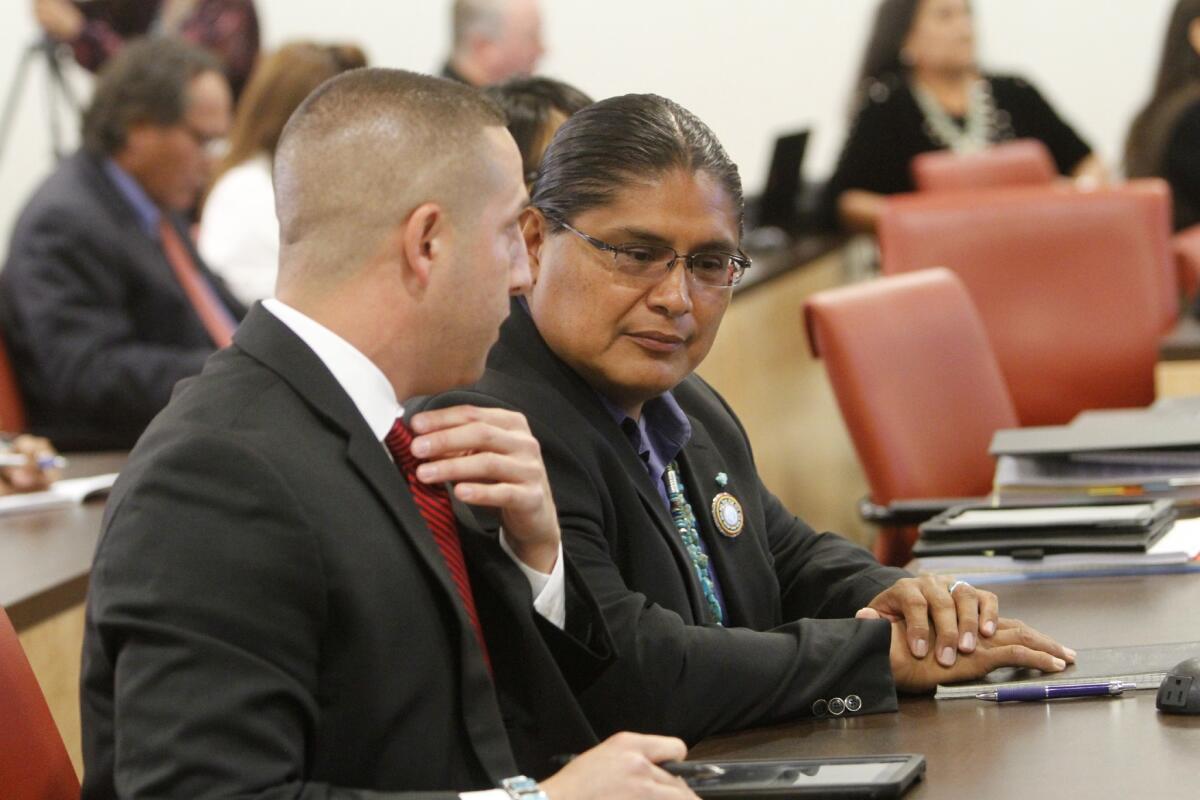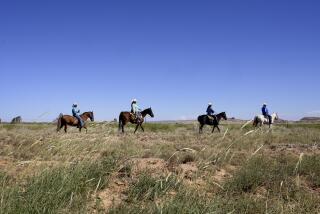For Navajo Nation, candidate stirs questions about saving dying language

Reporting from Window Rock, Ariz. — Navajo elder Jay Tsosie winces when he recalls those torturous classroom drills from his childhood.
Back when the 77-year-old was a skinny, rambunctious schoolboy, teachers from the federal Bureau of Indian Affairs tried to exorcise a part of Tsosie that he considers integral to his very being: his native language.
When caught whispering Navajo to classmates, Tsosie felt the wrath of an often sadistic English-only system: Teachers washed his mouth with soap and forced him to kneel on pencils and hold two heavy soda bottles in his outstretched arms.
“Some days,” Tsosie said, “I had to write on the blackboard 100 times: ‘I will not speak Navajo.’”
Decades later, the Navajo tongue has triggered a major rift in the upcoming presidential election of the country’s largest sovereign Native American nation.
This week the tribe’s high court struck candidate Christopher Deschene from the ballot because other contenders disputed that he was fluent in Navajo, a requirement for the office under tribal law. Deschene also refused to take a language competency test.
The subject may be politics, but the underlying issue is identity.
“Our sacred language defines us as individuals and as a nation,” the justices wrote in their decision.
On Thursday, the high court postponed the election, originally set for next month, to allow officials time to print new ballots without Deschene’s name.
Efforts to reach Deschene for comment were unsuccessful.
Some support the court’s ruling, calling fluency in the ancient language crucial for leading the nation of 300,000 members, many of whom live off the reservation. They say the requirement evolved from the BIA’s efforts years ago to quash the language.
To ignore the requirement, they say, insults elders such as Tsosie, who as youth paid the price for speaking Navajo under the control of the BIA, which many said stood for “Boss Indians Around.” How else can a leader reach older monolingual Navajo?
But a 94-year-old woman who says she is Deschene’s grandmother says he speaks Navajo well enough to carry on a conversation about his plans as president. “I understand him,” she said through an interpreter.
Others say the requirement penalizes younger, non-fluent Navajos for doing just what the tribe encourages them to do: Get an education in the outside world.
Along the state road south to Gallup, N.M., a route designated the Code Talker Highway to memorialize Navajos who used their language as a tool against the Japanese in World War II, billboards showing young Navajos in graduation gowns carry inspiring slogans: “Climb the ladder,” “Go Out Into the World” and “Learn English.”
Deschene, 43, was born in Los Angeles but grew up in Indian Country. He earned his master’s degree in engineering and later received a law degree, his campaign said. The father of two also served in the Marine Corps.
As a result, many here call Deschene a role model, not an embarrassment.
“We teach our kids to get that education and then to come back to the reservation and help their people, just like Chris did,” Art Huskey, 71, said as he stood outside the tribal council chambers Thursday. “Part of the sacrifice might be forgetting some of their Navajo.”
Huskey says Navajo has long been in decline. He and other protesters say that decades ago, 90% of tribal first-graders spoke the language fluently. Now that percentage is 30%. He said only one of his four children and none of his grandkids speaks the language.
Huskey was among the scores of people who protested Thursday outside the government building in Window Rock, Ariz., capital of the Navajo Nation, the largest territory of a sovereign Native American nation in North America. The area is sacred in Navajo culture.
Huskey, an electrical lineman who works off-reservation, said he speaks more English and Spanish than Navajo to survive in the outside job market. “No matter how you try to maintain the language, we fend for ourselves in the outside society dominated by English.”
Holding a protest sign, half-Navajo Mattie Christensen said she feels 100% Navajo, no matter her linguistic skills. “People try to put me down,” she said. “They say, ‘You can’t even speak the language.’ Well, you can’t take my culture away from me.”
But Sarah White holds the tribal president to a higher standard. “If my grandson grows up not speaking Navajo, that’s his choice, but if he ever ran for tribal president, I’d say, ‘Learn the language first. That’s the only way you’re going to feel and taste the experience of everyday Navajo life.’”
Tsosie says that though he still speaks Navajo, he won’t teach his grandkids the complicated language, which lacks clear equivalents for some English words. For example, “computer” becomes “thinking metal.”
“What’s the use?” Tsosie said. “We’ve been discouraged from using our language all our lives. Why make this an issue now when we have a bright young lawyer who wants to return to lead our tribe? Speaking the language is not going to do him any good, other than talking to the old folks. There are translators for that.”
Standing under a shade tree, away from the protesters, Wayne Claw said he too worried that the tribe was sending the wrong message. “My kids are now asking me, ‘Dad, we don’t speak Navajo either. Does that mean we don’t get to vote?’” Knowledge of Navajo is not a requirement for voting.
“If our kids don’t speak Navajo, that’s the fault of the parents; that’s our job. But don’t blame the kids. Don’t hold them back in life any more than they’ve already been held back,” he said.
The protest became tense when a tribal officer ordered activists to remove their signs.
“They’re defacing public property,” Tribal Police Sgt. Stanley Ashley said. “It doesn’t look good. You don’t see them at the White House.”
“Is it against the law? Or you don’t think it looks good?” one woman shouted.
Ashley glared. “You stay out of this, ma’am.”
In the end, the signs stayed, bearing messages in both English and Navajo. Later, protesters tried to decipher one sign in Navajo; they eventually determined it praised code talkers.
But there were moments of doubt, even for native speakers. Three elders read the sign and still racked their brains. Finally, one spoke up: “Somebody here wrote this sign. We should be able to figure this out.”
Twitter: @jglionna
More to Read
Sign up for Essential California
The most important California stories and recommendations in your inbox every morning.
You may occasionally receive promotional content from the Los Angeles Times.










